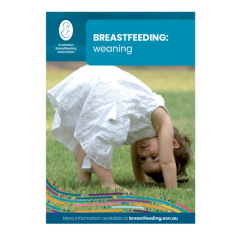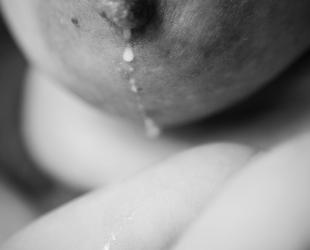If you have to stop breastfeeding suddenly, there are ways to wean quickly

There are a number of reasons why you may need to stop breastfeeding straight away:
You need to wean for personal or medical reasons. While perhaps not relevant for you, with help and support some mums are able to find a way to continue to offer their baby some breastmilk.
Your baby will be fed by someone else. This may happen if: you are a surrogate mother; your partner is to feed the baby; you are giving up the baby for adoption; your baby is no longer in your care.
Your breastfed baby has died or your baby died during pregnancy or at birth.
This article gives you some practical ways of coping, as you suppress your milk supply and come to terms with why you need to do this.
Suppressing milk supply from birth
If your breasts are firmly supported and you don't express milk more than you need to for comfort, your milk supply will decrease over time.
Here are some suggestions if you need to stop your breasts from making milk more quickly:
Wear a firm bra both day and night to support your breasts and keep you comfortable.
Whenever your breasts feel too full, express a little milk. Express only enough to make you comfortable.
Handle your breasts very gently as they can bruise easily.
Use breast pads to soak up any leaking milk. Change them as they become wet.
Relieve pain and swelling using cool compresses placed on your breasts or in your bra.
Mild painkiller medications may help relieve pain and inflammation. Your doctor will be able to advise you about this.
Drink when you are thirsty. Cutting down fluids will not help reduce your milk supply.
If your breasts are very full, you may find it uncomfortable to lie in bed. Try lying on your back or on one side with an extra pillow supporting your breasts. If you like to lie on your front, place a pillow under your hips and stomach to ease the pressure on your breasts. Place a soft towel or cloth nappy across your breasts to soak up any leaking milk.
Most women can stop their breasts making milk by limiting the amount of milk removed, wearing a firm bra, using cool packs and taking pain relief if needed.
Suppressing milk supply after weeks or months of breastfeeding
The ideas above may not be enough if you suddenly need to stop producing milk and you already have a full supply. A mother of a fully breastfed baby can produce up to a litre of milk a day or more. It can take some time to stop all this milk being made.
To stop making milk you will need to limit how much you remove from your breasts. This will send a message to your body to make less milk.
It may be more comfortable for you to suppress your milk supply gradually. Your hormone levels will reduce and your breasts will return to ‘normal’ more slowly. This is more like natural weaning and helps prevent mastitis.
However, first you may need to deal with the problem of overfull breasts.
Start by expressing as many times as you had been breastfeeding, or less depending on your own comfort.
Over time, reduce the amount of milk you express each time and/or drop one expression every 3 to 4 days. If your breasts become overfull, you can slow down the process and express a little more to keep yourself comfortable.
When you are ready, simply stop expressing. You may find that you need to express once every few days towards the end.
Can drugs help?
Most prescribed drugs used to suppress lactation work by reducing prolactin, the hormone involved in making milk. For this reason, they only work in the early days or weeks after birth when prolactin levels are high. They don't work as well if used after weeks or months of breastfeeding.
It is preferable to suppress lactation without medication. Talk over the use of lactation suppression drugs with your doctor before making a decision about whether they are right for you.
Things to watch out for
You may experience milk leaking from your breasts during the weaning process. You can use breast pads but avoid those that will keep your skin damp. Make sure your bra is roomy enough to hold whatever sort of pad you choose without putting pressure on your breasts.
If you wear your bra to bed, take care that it doesn’t press in when you are lying down as this may lead to inflammation of the breast. Stop the flow if you need to. If your milk starts to leak out strongly (ie your milk ‘lets down’) you can stop the overflow by pressing firmly on your nipple with your hand or forearm for several seconds.
If your breasts become engorged and the ideas given above don't work to keep you comfortable, it may help to express all the milk in your breasts, just once, with an electric breast pump. This can relieve the pressure and from then on, you may be able to prevent it building up to that point again.
If breasts are left very full, there is a risk that you could develop localised breast inflammation. This can lead to mastitis if not treated early and effectively.
How long before the milk goes away?
This depends on a few things including:
How old your baby was and how much milk you were making, or your stage of pregnancy if you had not yet given birth.
How much milk is taken from the breast through expressing, let-downs and leaking.
How much your nipples are touched, such as during sex.
If you are pregnant again.
Some mothers find it takes weeks for their milk to go away completely. Others find that it takes only days. You may notice milk stains on your bra or that you leak during or after a shower. You may even feel the let-down months after suppressing your milk supply. Every mother will have a slightly different experience.
If you are suppressing your milk supply following the loss of your baby, it is important for you to have support. You will feel a range of emotions as you grieve for your precious little one.
© Australian Breastfeeding Association February 2023
Read more about weaning
Evidence-led info and practical tips from our Breastfeeding Information Series
Breastfeeding: weaning



